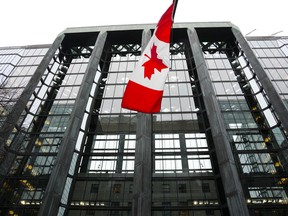A growing chorus of investors is buying bonds from certain developed nations where they believe interest rates will be cut sooner and faster than many economists expect.
Economy
Canada among investors’ favourite bets for sooner-than-expected interest rate cut

“The U.S. economy is structurally healthier and able to withstand higher rates for longer than those economies with household leverage imbalances,” said Iain Cunningham, a portfolio manager at Ninety-One Asset Management.
Investors holding those bets argue that these economies are way more exposed to higher interest rates than the U.S. due to their more elevated household debt levels, and the full effect of their tightening cycles is yet to kick in.
Household debt accounts for about 190 per cent of gross domestic product in Australia, Sweden and South Korea, according to the latest available OECD data referring to the end of 2021. That compares with a ratio of around 95 per cent in the U.S. and Germany.
Since late last year, Harvey has increased his exposure to Sweden, Norway and Australia, with the latter being the U.S.-based fund’s biggest exposure excluding Treasuries.
While Australia surprised markets this month by raising interest rates, minutes from the meeting show that the decision was a finely balanced one, given risks to the economy and employment, and Harvey doesn’t rule out cuts later this year as the economy slows. That goes against swaps pricing, which implies the key rate being lifted by an additional 54 basis points to 4.64 per cent by December before cuts begin in the second half of 2024.
Brendan Murphy, a portfolio manager at Insight Investment, which manages around US$1 trillion, is buying South Korean bonds betting the country could take a relatively big hit if global economic growth slows in the coming months.
South Korea’s central bank held policy rates unchanged for a third straight meeting in May, while reinforcing a message that another hike may be possible amid sticky inflation. Prior to the BOK’s announcement, investors and many analysts were betting on rate cuts in Korea later this year, as risks to economic growth build.
“The danger for markets, and risk assets in particular, is that central banks effectively have to sacrifice growth to get inflation back under control,” Ninety-One’s Cunningham said.
— with assistance from Alice Gledhill

Economy
September merchandise trade deficit narrows to $1.3 billion: Statistics Canada

OTTAWA – Statistics Canada says the country’s merchandise trade deficit narrowed to $1.3 billion in September as imports fell more than exports.
The result compared with a revised deficit of $1.5 billion for August. The initial estimate for August released last month had shown a deficit of $1.1 billion.
Statistics Canada says the results for September came as total exports edged down 0.1 per cent to $63.9 billion.
Exports of metal and non-metallic mineral products fell 5.4 per cent as exports of unwrought gold, silver, and platinum group metals, and their alloys, decreased 15.4 per cent. Exports of energy products dropped 2.6 per cent as lower prices weighed on crude oil exports.
Meanwhile, imports for September fell 0.4 per cent to $65.1 billion as imports of metal and non-metallic mineral products dropped 12.7 per cent.
In volume terms, total exports rose 1.4 per cent in September while total imports were essentially unchanged in September.
This report by The Canadian Press was first published Nov. 5, 2024.
The Canadian Press. All rights reserved.
Economy
How will the U.S. election impact the Canadian economy? – BNN Bloomberg
[unable to retrieve full-text content]
How will the U.S. election impact the Canadian economy? BNN Bloomberg

Source link
Economy
Trump and Musk promise economic 'hardship' — and voters are noticing – MSNBC
[unable to retrieve full-text content]
Trump and Musk promise economic ‘hardship’ — and voters are noticing MSNBC

Source link
-

 News24 hours ago
News24 hours agoJustin Trudeau’s Announcing Cuts to Immigration Could Facilitate a Trump Win
-

 News11 hours ago
News11 hours agoAlberta aims to add two seats to legislature, bringing total to 89 for next election
-

 News11 hours ago
News11 hours agoPembina Pipeline earnings rise year over year to $385 million in third quarter
-

 News19 hours ago
News19 hours agoUN refugee chief: Canada cutbacks can avoid anti-immigrant backlash
-

 News19 hours ago
News19 hours agoParty leaders pay tribute following death of retired senator Murray Sinclair
-

 News19 hours ago
News19 hours agoTrump snaps at reporter when asked about abortion: ‘Stop talking about it’
-

 News19 hours ago
News19 hours agoBeyoncé channels Pamela Anderson in ‘Baywatch’ for Halloween video asking viewers to vote
-

 News19 hours ago
News19 hours agoCanadians remember Quincy Jones





















